Kenwood DDX5025BT, DDX5025DAB, DDX5055BT, DDX7025BT, DDX7055BT Instruction Manual
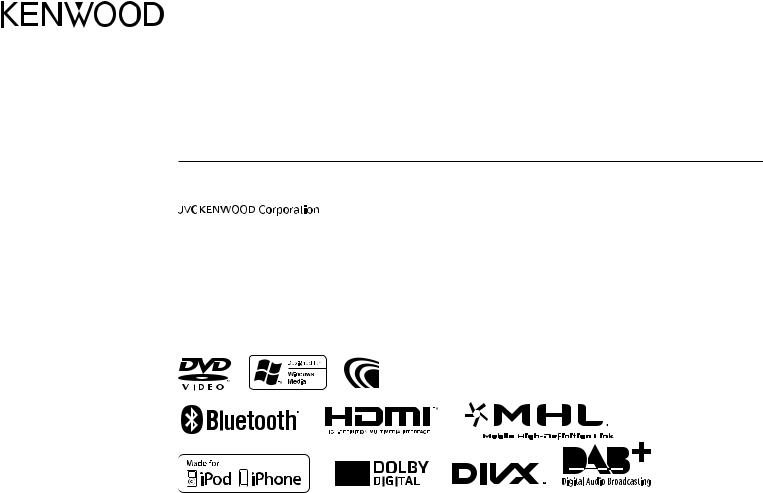
DDX7025BT DDX5025BT DDX7055BT DDX5055BT DDX5025DAB
MONITOR WITH DVD RECEIVER
INSTRUCTION MANUAL
© 2014 JVC KENWOOD Corporation |
LVT2513-001A (EN/QN) |

CONTENTS
BEFORE USE............................................................ |
2 |
How to reset your unit.................................................... |
3 |
INITIAL SETTINGS .................................................. |
4 |
BASICS .................................................................... |
6 |
Component names and functions............................. |
6 |
Common operations....................................................... |
7 |
Common screen operations......................................... |
8 |
Selecting the playback source..................................... |
9 |
DISCS .................................................................... |
10 |
USB........................................................................ |
15 |
iPod/iPhone ......................................................... |
16 |
APPs...................................................................... |
19 |
TUNER................................................................... |
20 |
DIGITAL RADIO (DAB) |
|
(Only for DDX5025DAB)...................................... |
23 |
OTHER EXTERNAL COMPONENTS ...................... |
27 |
Using external audio/video players—AV-IN ........ |
27 |
Using a rear view camera ............................................ |
27 |
Using a smartphone—HDMI/MHL........................... |
28 |
Watching a TV.................................................................. |
28 |
Using the external navigation unit.......................... |
29 |
BLUETOOTH ......................................................... |
30 |
SETTINGS.............................................................. |
38 |
Settings for using applications of the iPod/ |
|
iPhone/Android .............................................................. |
38 |
Sound adjustment ......................................................... |
39 |
Adjustment for video playback................................. |
41 |
Changing display design............................................. |
43 |
Customizing the <TOP MENU> screen .................. |
44 |
Customizing the system settings ............................. |
44 |
Setting menu items....................................................... |
46 |
REMOTE CONTROLLER ........................................ |
49 |
CONNECTION/INSTALLATION ............................ |
53 |
REFERENCES......................................................... |
59 |
Maintenance .................................................................... |
59 |
More information........................................................... |
59 |
Error message list ........................................................... |
63 |
Troubleshooting............................................................. |
64 |
Specifications................................................................... |
66 |
How to read this manual:
•Illustrations of DDX7025BT are mainly used for explanation. The displays and panels shown in this manual are examples used to provide clear explanations of the operations. For this reason, they may be different from the actual displays or panels.
•This manual mainly explains operations using the buttons on the monitor panel and touch panel. For operations using the remote controller (KNA-RCDV331: optional accessory), see page 49.
•< > indicates the various screens/menus/operations/settings that appear on the touch panel.
•[ ] indicates the buttons on the touch panel.
•Indication language: English indications are used for the purpose of explanation. You can select the indication language from the <Setup> menu. (Page 48)
BEFORE USE
USE
V WARNINGS: (To prevent accidents and damage)
•DO NOT install any unit or wire any cable in a location where;
–it may obstruct the steering wheel and gearshift lever operations.
–it may obstruct the operation of safety devices such as air bags.
–it may obstruct visibility.
•DO NOT operate the unit while driving.
If you need to operate the unit while driving, be sure to look around carefully.
•The driver must not watch the monitor while driving.
The marking of products using lasers
The label is attached to the chassis/case and says that the component uses laser beams that have been classified as Class 1. It means that the unit is utilizing laser beams that are of a weaker class. There is no danger of hazardous radiation outside the unit.
2

BEFORE USE
USE
Information on Disposal of Old Electrical and Electronic Equipment and Batteries (applicable for EU countries that have adopted separate waste collection systems)
Products and batteries with the symbol (crossedout wheeled bin) cannot be disposed as household waste.
Old electrical and electronic equipment and batteries should be recycled at a facility capable of handling these items and their waste byproducts. Contact your local authority for details in locating a recycle facility nearest to you.
Proper recycling and waste disposal will help conserve resources whilst preventing detrimental effects on our health and the environment.
Notice: The sign “Pb” below the symbol for batteries indicates that this battery contains lead.
For Israel
For Turkey
Bu ürün 28300 sayılı Resmi Gazete’de yayımlanan Atik Elektrikli ve Elektronik Eşyalarin Kontrolü Yönetmeliğe uygun olarak üretilmiştir.
Eski Elektrik ve Elektronik Ekipmanların İmha Edilmesi Hakkında Bilgi (ayrı atık toplama sistemlerini kullanan ülkeleri için uygulanabilir)
Sembollü (üzerinde çarpı işareti olan çöp |
kutusu) ürünler ev atıkları olarak atılamaz. |
Eski elektrik ve elektronik ekipmanlar, |
bu ürünleri ve ürün atıklarını |
geri dönüştürebilecek bir tesiste |
değerlendirilmelidir. Yaşadığınız bölgeye |
en yakın geri dönüşüm tesisinin yerini |
öğrenmek için yerel makamlara müracaat |
edin. Uygun geri dönüşüm ve atık |
imha yöntemi sağlığımız ve çevremiz |
üzerindeki zararlı etkileri önlerken |
kaynakların korunmasına da yardımcı |
olacaktır. |
V Cautions on the monitor:
•The monitor built into this unit has been produced with high precision, but it may have some ineffective dots. This is inevitable and is not considered defective.
•Do not expose the monitor to direct sunlight.
•Do not operate the touch panel using a ball-point pen or similar tool with a sharp tip.
Touch the buttons on the touch panel with your finger directly (if you are wearing a glove, take it off).
•When the temperature is very cold or very hot...
–Chemical changes occur inside, causing malfunction.
–Pictures may not appear clearly or may move slowly. Pictures may not be synchronized with the sound or picture quality may decline in such environments.
Fors afety...
•Do not raise the volume level too much, as this will make driving dangerous by blocking outside sounds, and may cause hearing loss.
•Stop the car before performing any complicated operations.
Temperature inside the car...
If you have parked the car for a long time in hot or cold weather, wait until the temperature in the car becomes normal before operating the unit.
How to reset your unit
DDX7025BT/DDX7055BT
DDX5025DAB/DDX5025BT/DDX5055BT
If the unit fails to operate properly, press the Reset button. The unit returns to factory settings when the Reset button is pressed (except the registered Bluetooth devices).
ENGLISH 3
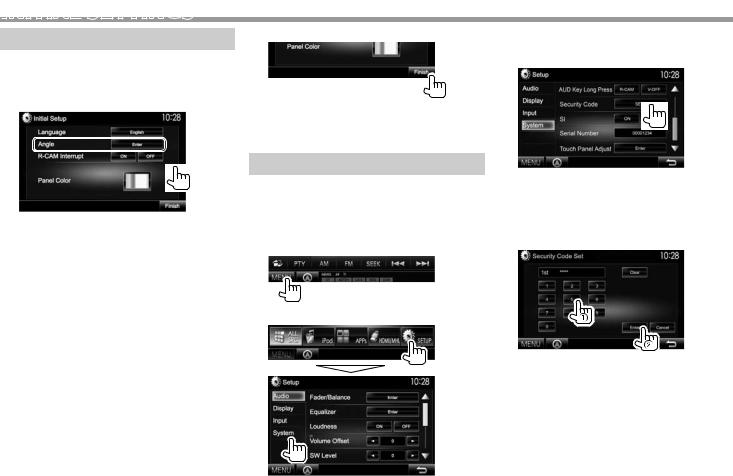
INITIAL
 SETTINGS
SETTINGS
Initials etup
When you power on the unit for the first time or reset the unit, the initial setting screen appears.
•You can also change the settings on the <Setup> screen. (Page 46)
1
*
<Language> Select the text language used for (Page 48) on-screen information.
|
• Set <GUI Language> to |
|
display the operation buttons |
|
and menu items in the |
|
selected language ([Local]: |
|
initially selected) or English |
|
([English]). |
<Angle>* |
Adjust the panel angle. |
(Page 7) |
|
<R-CAM |
Select [ON] when connecting |
Interrupt> |
the rear view camera. |
(Page 47) |
|
<Panel |
Select the color of the buttons |
Color> |
on the monitor panel. |
(Page 43) |
|
2 Finish the procedure.
The <TOP MENU> screen is displayed.
* Onlyfor DDX7025BT/DDX7055BT.
Setting the security function
You can set a security code to protect your receiver system against theft.
Registering the security code
1Display the <TOP MENU> screen.
On the source control screen:
2 Display the <System> setting screen.
3Display the <Security Code Set> screen.
•Press [K] repeatedly to change the page on the <System> menu screen.
•To clear the registered security code, perform steps 1 and 2, then press [CLR] in <Security Code>.
4Enter a four-digit number (1), then confirm the entry (2).
•Press [Clear] to delete the last entry.
•Press [Cancel] to cancel the setting.
5Repeat step 4 to confirm your security code.
Now, your security code is registered.
•When the unit is being reset or disconnected from the battery, you are required to enter the security code. Enter the correct security code, then press
[Enter].
4
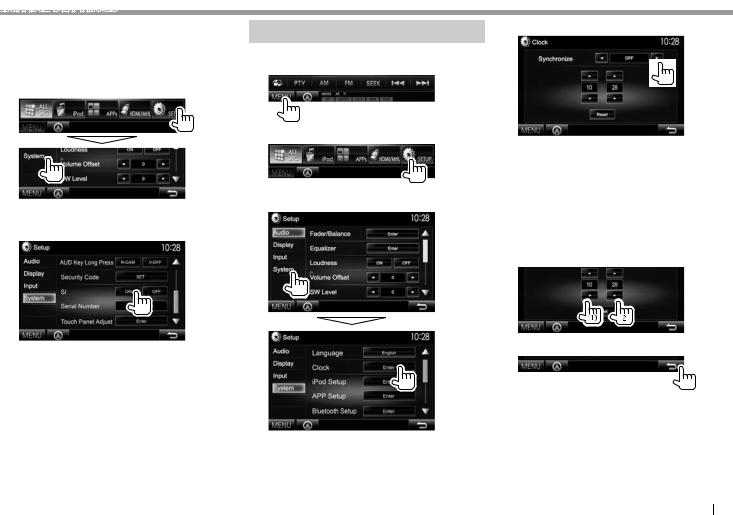
INITIAL
 SETTINGS
SETTINGS
Activating the security function
You can activate the security function to protect your receiver system against theft.
1Display the <System> setting screen.
On the <TOP MENU> screen:
•Press [K] repeatedly to change the page on the <System> menu screen.
2
The security indicator on the monitor panel flashes when the vehicle ignition is off.
To deactivate the security function: Select [OFF] for <SI>.
Clock settings
1Display the <TOP MENU> screen.
On the source control screen:
2 Display the <Setup> screen.
3 Display the <Clock> screen.
4 Set the clock time.
<NAV>* Synchronizes the clock time with the connected navigation unit.
<Radio Data Synchronizes the clock time with System> FM Radio Data System.
<OFF> Sets the clock manually. (See below.)
When selecting <OFF>:
Adjust the hour (1), then adjust the minute (2).
• Press [Reset] to set the minute to “00”.
5 Finish the procedure.
* Appears only when the navigation unit is connected.
ENGLISH 5

BASICS
Component names and functions
DDX7025BT/DDX7055BT
1 Monitor panel*
2 Screen (touch panel)
3Reset button/Power indicator/Security indicator
•Resets the unit. (Page 3)
•Lights up while the unit is turned on.
•Flashes when the security function is activated. (Page 5)
4Volume K/J button
Adjusts the audio volume. (Page 7)
5AV/AV OUT button
•Displays the current source screen. (Press)
•The function of the button when held varies depending on the <AV Key Long Press> setting. (Page 48)
6AUD/R-CAM button
•Displays the <Equalizer> screen. (Press) (Page 39)
•The function of the button when held varies depending on the <AUD Key Long Press> setting. (Page 48)
7  MENU button
MENU button
•Displays the <TOP MENU> screen. (Press) (Page 8)
•Turns off the power. (Hold) (Page 7)
•Turns on the power. (Press) (Page 7)
8TEL/VOICE button
•Displays the phone control screen. (Press) (Page 34)
•Activates voice dialing. (Hold) (Page 35) 9 M (Eject) button
•Ejects the disc. (Tilts the monitor panel fully.)
•Opens/closes the monitor panel.
DDX5025DAB/DDX5025BT/DDX5055BT
1Reset button/Power indicator/Security indicator
•Resets the unit. (Page 3)
•Lights up while the unit is turned on.
•Flashes when the security function is activated. (Page 5)
2M (Eject) button Ejects the disc.
3 Loading slot
4  MENU button
MENU button
•Displays the <TOP MENU> screen. (Press) (Page 8)
•Turns off the power. (Hold) (Page 7)
•Turns on the power. (Press) (Page 7)
5AV/AV OUT button
•Displays the current source screen. (Press)
•The function of the button when held varies depending on the <AV Key Long Press> setting. (Page 48)
6Volume/ATT/AUD knob
•Attenuates the sound. (Press) (Page 7)
•Adjusts the audio volume. (Turn) (Page 7)
•Displays the <Equalizer> screen. (Hold) (Page 39)
7TEL/VOICE button
•Displays the phone control screen. (Press) (Page 34)
•The function of the button when held varies depending on the <TEL Key Long Press> setting. (Page 48)
8 Monitor panel*
9 Screen (touch panel)
*You can change the color of the buttons on the monitor panel. (Page 43)
V Caution on the volume setting:
Digital devices produce very little noise compared with other sources. Lower the volume before playing these digital sources to avoid damaging the speakers by sudden increase of the output level.
6
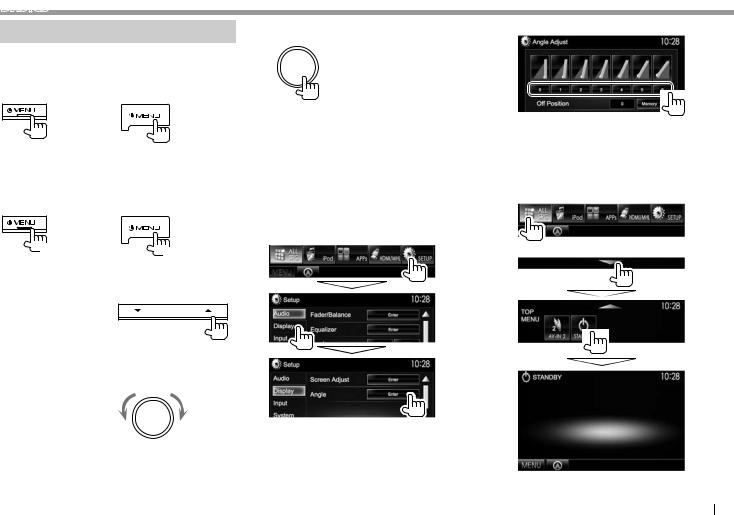
BASICS
Common operations
Turning on the power
DDX7025BT DDX5025DAB DDX7055BT DDX5025BT
DDX5055BT
Turning off the power
DDX7025BT DDX5025DAB DDX7055BT DDX5025BT
DDX5055BT
(Hold) |
(Hold) |
|
Adjusting the volume
To adjust the volume (00 to 35) DDX7025BT
DDX7055BT
Press J to increase, and press K to decrease.
•Holding the button increases/decreases the volume continuously.
DDX5025DAB
DDX5025BT
DDX5055BT
Turn to the right to increase, and turn to the left to decrease.
To attenuate the sound (only for DDX5025DAB/ DDX5025BT/DDX5055BT)
The ATT indicator lights up.
To cancel the attenuation: Press the same button again.
Adjusting the panel angle (only for DDX7025BT/DDX7055BT)
1Display the <Angle Adjust> screen.
On the <TOP MENU> screen:
•Press [K] repeatedly to change the page on the <Display> menu screen.
2 Select an angle (0 – 6).
•To set the current position as the power off position, select [Memory].
Putting the unit in standby
1 Display all <TOP MENU> items.
On the <TOP MENU> screen:
2
ENGLISH 7

BASICS
Turning off the screen
DDX7025BT DDX5025DAB DDX7055BT*1 DDX5025BT
DDX5055BT*2
(Hold)
(Hold)
To turn on the screen: Press  MENU on the monitor panel, or touch the display.
MENU on the monitor panel, or touch the display.
*1 This operation works only when <AUD Key Long Press> is set to [V-OFF]. (Page 48)
*2 This operation works only when <TEL Key Long Press> is set to [V-OFF]. (Page 48)
Common screen operations
Common screen descriptions
You can display other screens any time to change the source, show the information, or change the settings, etc.
Source control screen
Performs source playback operations.
•The operation buttons vary depending on the selected source.
1
2
34
Common operation buttons:
1Displays other operation buttons.
•Disabled when there are no other buttons. 2 Switches between the normal source control screen and easy control screen. (See below.)
3 Displays the <TOP MENU> screen. (See the right column.)
•Pressing  MENU on the monitor panel also displays the <TOP MENU> screen.
MENU on the monitor panel also displays the <TOP MENU> screen.
4Displays the screen of the connected navigation unit.* (Page 29)
Easy control screen
Pressing [ ] switches between the normal source control screen and easy control screen.
] switches between the normal source control screen and easy control screen.
The easy control screen allows you to control the source easily with simple buttons.
•The displayed buttons vary depending on the selected source.
<TOP MENU> screen
Displays the source control screen and settings screen.
1 |
2 |
3
Common operating buttons:
1Changes the playback source. (Page 9)
•Press [ALL SRC] to display all <TOP MENU> items. (Page 9)
•You can arrange the items to display on the <TOP MENU> screen. (Page 44)
2 Displays the phone control screen. (Page 34)
3 Displays the <Setup> screen. (See below.)
<Setup> screen
Changes the detailed settings. (Page 46)
1
|
|
3 |
|
2 |
4 |
Common operating buttons: |
|
|
1 |
Selects the menu category. |
|
2 |
Displays the <TOP MENU> screen. |
|
3 |
Changes the page. |
|
4 |
Returns to the previous screen. |
|
* Appears only when a navigation unit is connected.
8
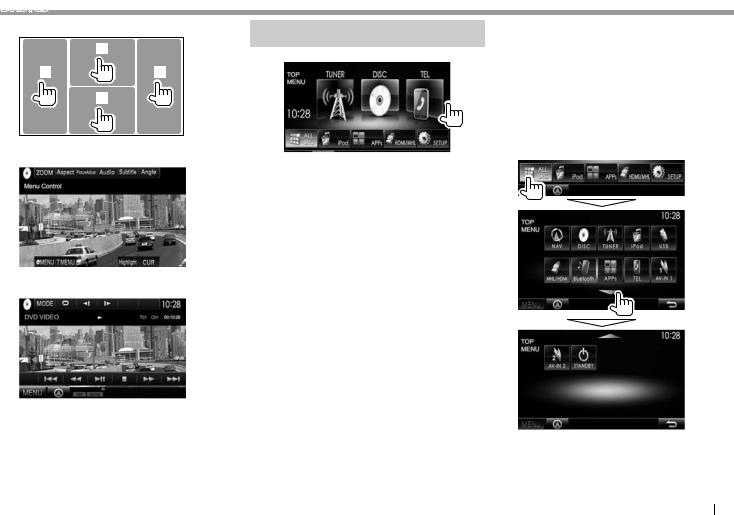
BASICS
Touch screen operations
1
3 |
4 |
2
1Displays the video control menu while playing a video.
2Displays the source control screen while playing a video.
•The operation buttons disappear when the screen is touched or when no operation is done for about 5 seconds.
3 Goes to the previous chapter/track.*
4 Goes to the next chapter/track.*
* Not available for video from an external component.
Selecting the playback source
On the <TOP MENU> screen:
•You can change the items (other than [SETUP]) to display on the <TOP MENU> screen. (Page 44)
Displays the navigation screen when a navigation unit is connected. (Page 29)
Plays a disc. (Page 10)
Switches to the radio broadcast. (Page 20)
Switches to the digital audio broadcast (DAB). (Page 23) Plays an iPod/iPhone. (Page 16) Plays files on a USB device. (Page 15)
Plays a device connected to the HDMI/MHL input terminal. (Page 28)
Plays a Bluetooth audio player. (Page 36)
Switches to the screen of App from the connected iPod touch/ iPhone. (Page 19)
Displays the phone control screen. (Page 34)
[AV-IN1][AV-IN2]
Switches to an external component connected to the AVIN1 or iPod/AV-IN2 input terminal. (Page 27)
*1 When no navigation unit is connected, “No Navigation” appears. *2 Only for DDX5025DAB.
To display all sources and items on the <TOP MENU> screen
•You can change the page to display more items by pressing [J]/[K].
ENGLISH 9
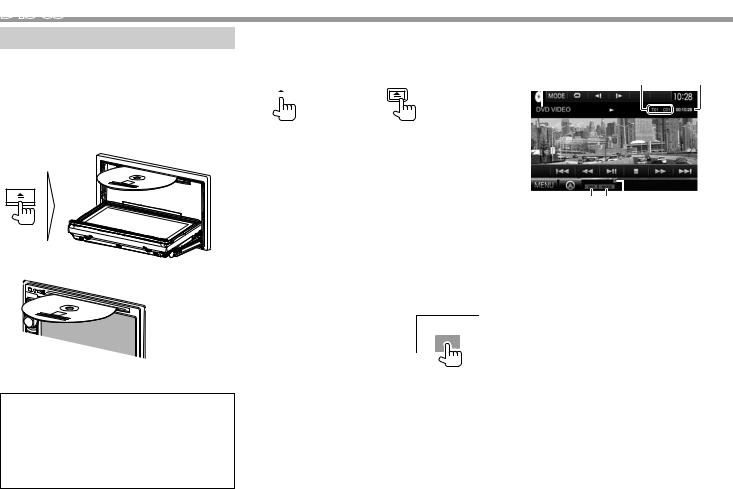
DISCS
Playing a disc
•If a disc does not have a disc menu, all tracks on it will be played repeatedly until you change the source or eject the disc.
•For playable disc types/file types, see page 60.
Inserting a disc
Insert a disc with the label side facing up.
DDX7025BT/DDX7055BT
DDX5025DAB/DDX5025BT/DDX5055BT
The source changes to “DISC” and playback starts.
•The IN indicator lights up while a disc is inserted.
•If “ ” appears on the screen, the unit cannot accept the operation you have tried to do.
” appears on the screen, the unit cannot accept the operation you have tried to do.
–In some cases, without showing “ ,” operations will not be accepted.
,” operations will not be accepted.
•When playing back a multi-channel encoded disc, the multi-channel signals are downmixed to stereo.
Ejecting a disc
DDX7025BT |
DDX5025DAB |
||||
DDX7055BT |
DDX5025BT |
||||
|
|
|
|
|
DDX5055BT |
|
|
|
|
|
|
|
|
|
|
|
|
|
|
|
|
|
|
|
|
|
|
|
|
Indications and buttons on the source control screen
For DVD/DVD-VR/VCD/DivX/MPEG1/MPEG2
1 |
2 |
3 |
• When removing a disc, pull it horizontally. |
|
|
|
• You can eject a disc when playing another AV |
|
|
|
source. |
|
|
|
• If the ejected disc is not removed within |
|
|
|
60 seconds, the disc is automatically inserted |
|
|
|
again into the loading slot to protect it from dust. |
|
4 5 6 |
|
Closing the monitor panel (only for DDX7025BT/ |
Playback information |
||
1 |
Media type |
||
DDX7055BT) |
|||
2 |
Current playback item information |
||
After removing the disc, press M on the monitor |
|||
|
• DVD Video: Title no./Chapter no. |
||
panel. The monitor panel closes. |
|
||
|
• DVD-VR: Program no. (or Playlist no.)/Chapter |
||
|
|
||
|
|
no.* |
|
Playback operations |
|
||
|
• DivX/MPEG1/MPEG2: Folder no./Track no. |
||
|
|
• VCD: Scene no. (with PBC) or Track no. (without |
|
When the operation buttons are |
|
PBC) |
|
not displayed on the screen, touch |
3 |
Playing time |
|
the area shown on the illustration. |
4 |
Playback mode (Page 13) |
|
• To change settings for video |
5 |
File type (for DivX/MPEG1/MPEG2) |
|
playback, see page 41. |
6 |
IN indicator |
|
* To display the Original Program/Playlist screen, see page 11.
10

DISCS
Operation buttons
[ |
] |
|
|
|
Displays the easy control screen. |
|
|
|
|
|
|
|
(Page 8) |
[ |
]*1 |
|
Displays the folder/track list. |
|||
|
|
|
|
|
|
(Page 12) |
[O] [N] |
• Reverse/forward search during |
|||||
|
|
|
|
|
|
playback.*2 |
[S] [T] |
• Selects a chapter/track. (Press) |
|||||
|
|
|
|
|
|
• Reverse/forward search.*2 (Hold) |
[IW] |
|
Starts/pauses playback. |
||||
[o] |
|
Stops playback. |
||||
[ |
] |
|
|
|
Displays other operation buttons. |
|
|
|
|
|
|
|
• Disabled when there are no other |
|
|
|
|
|
|
buttons. |
[MODE] |
Changes the settings for disc |
|||||
|
|
|
|
|
|
playback on the <DISC Mode> |
|
|
|
|
|
|
screen. (Page 14) |
[ |
] [ |
]*3 |
Selects playback mode. (Page 13) |
|||
[Playlist]*4 |
Displays an Original Program/Playlist |
|||||
|
|
|
|
|
|
screen. |
[ |
|
] [ |
|
|
]*5 |
Plays in frame-by-frame. |
|
|
|||||
|
|
|||||
[ |
] [ |
|
]*1 |
Selects a folder. |
||
[PBC]*6 |
|
Activates or deactivates the VCD PBC |
||||
|
|
|
|
|
|
(Playback Control) function. |
[MENU] |
Displays the <TOP MENU> screen. |
|||||
*1 Does not appear for DVD/DVD-VR/VCD.
*2 Search speed varies depending on the type of disc or file. *3 Does not appear for DVD/DVD-VR.
*4 Appears only for DVD-VR.
*5 Appears only for DVD/DVD-VR. *6 Appears only for VCD.
ForC D/MP3/WMA/AAC
1 2 3 4 5
6 7 8
Playback information
1 Media type
2Track/file information
•Pressing [<] scrolls the text if not all of the text is shown.
3Current playback item information
•MP3/WMA/AAC: Folder no./Track no.
•CD: Track no.
4 Playback status
5 Playing time
6 Playback mode (Page 13)
7 File type
8 IN indicator
Operation buttons
[ |
] |
|
Displays the easy control screen. |
|
|
|
(Page 8) |
[ |
]*1 |
|
Displays the folder/track list. |
|
|
|
(Page 12) |
[S] [T] |
Selects a track. |
||
[O] [N] |
Reverse/forward search.*2 |
||
[IW] |
|
Starts/pauses playback. |
|
[ |
] |
|
Displays other operation buttons. |
|
|
|
• Disabled when there are no other |
|
|
|
buttons. |
[MODE] |
Changes the settings for disc |
||
|
|
|
playback on the <DISC Mode> |
|
|
|
screen. (Page 14) |
[ |
] [ |
]*1 |
Selects a folder. |
[ |
] [ |
] |
Selects playback mode. (Page 13) |
[o] |
|
Stops playback. |
|
[MENU] |
Displays the <TOP MENU> screen. |
||
*1 |
Does not appear for CDs. |
||
*2 |
Search speed varies depending on the type of disc or file. |
||
ENGLISH 11

DISCS
Selecting a folder/track on the list
1
2Select the folder (1), then the item in the selected folder (2).
•Repeat the procedure until you select the desired track.
•You can change the page to display more items by pressing [J]/[K].
•Press [ ] to open the folder containing the current track.
] to open the folder containing the current track.
•Press [ ] to return to the root folder.
] to return to the root folder.
•Press [ ] to return to the upper layer.
] to return to the upper layer.
Video menu operations
You can display the video menu screen during video playback.
•Available items on the screen differ depending on the types of the loaded disc and playback files.
•The operation buttons disappear when the screen is touched or when no operation is done for about 5 seconds.
 *
*
 *
*
[ZOOM]* |
Displays the picture size selecting |
|
screen. (Page 42) |
[Aspect] |
Selects the aspect ratio. |
|
(Page 42) |
[PictureAdjust] |
Displays the picture adjustment |
|
screen. (Page 41) |
[Audio]* |
Selects the audio type (or channel |
|
for DVD-VR). |
[Subtitle]* |
Selects the subtitle type. |
[Angle]* |
Selects the view angle. |
[MENU]* |
Displays the disc menu. |
[T MENU]* |
Displays the disc menu (DVD). |
[CUR]* |
Displays the menu/scene |
|
selecting screen. |
|
• [J] [K] [H] [I]: Selects an item. |
|
• [Enter]: Confirms the selection. |
|
• [Return]: Returns to the |
|
previous screen. |
[Highlight]* |
Switches to the direct disc menu |
|
mode. Touch the target item to |
|
select. |
•To restore the screen, press AV on the monitor panel.
* May not appear depending on the media/file etc.
12
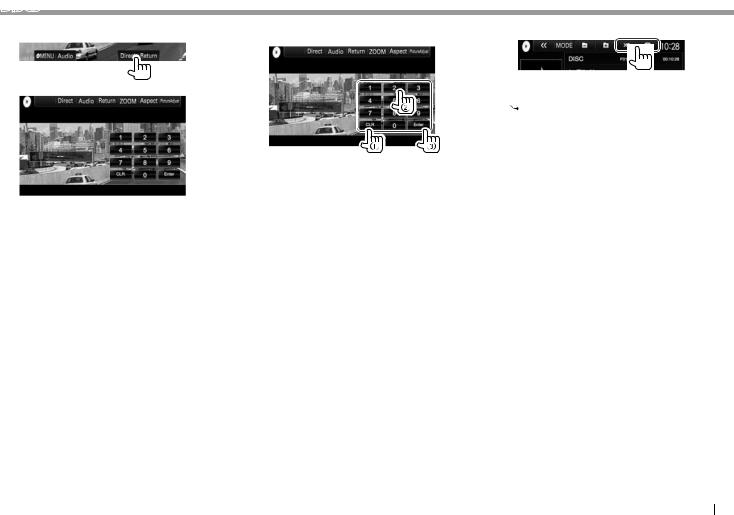
DISCS
For VCD
1
2
[ZOOM] |
Displays the picture size selecting |
|
screen. (Page 42) |
[Aspect] |
Selects the aspect ratio. |
|
(Page 42) |
[PictureAdjust] |
Displays the picture adjustment |
|
screen. (Page 41) |
[Audio] |
Selects the audio channel (ST: |
|
stereo, LL: left, RR: right). |
[Return] |
Displays the previous screen or |
|
menu. |
[Direct] |
Displays/hides the direct selecting |
|
buttons. (See the right column.) |
•To select a track directly, press [Direct] to display the direct selecting buttons, then...
–When you enter a wrong number, press [CLR] to delete the last entry.
Selecting playback mode
[ ] Selects Repeat playback mode.
] Selects Repeat playback mode.
[ ] Selects Random playback mode.
] Selects Random playback mode.
•For DVD/DVD-VR: Repeat play is available.
For VCD (without PBC)/CD/DivX/MPEG1/MPEG2/ MP3/WMA/AAC: Repeat and Random play are available.
–You cannot activate the repeat mode and the random mode at the same time.
•Each time you press the button, the playback mode changes. (The corresponding indicator lights up.)
–Available items differ depending on the types of loaded disc and playback file.
C-REP |
Repeats current chapter. |
T-REP |
Repeats current title/program. |
REP |
Repeats current track. |
FO-REP |
Repeats all tracks of the |
|
current folder. |
FO-RDM |
Randomly plays all tracks of |
|
the current folder, then tracks |
|
of the next folders. |
RDM |
Randomly plays all tracks. |
To cancel Repeat/Random playback: Press the button repeatedly until the indicator disappears.
ENGLISH 13

DISCS
Settings for disc playback
•The items available on the <DISC Mode> screen are different depending on the discs/files played back.
Setting items
<Menu |
Select the initial disc menu language. |
Language>* |
(Initial: English) (Page 62) |
<Audio |
Select the initial audio language. |
Language>* |
(Initial: Original) (Page 62) |
<Subtitle |
Select the initial subtitle language |
Language>* |
or turn subtitles off (Off). (Initial: |
|
English) (Page 62) |
<Dynamic |
You can change the dynamic range |
Range |
while playing Dolby Digital software. |
Control>* |
• Wide: Select this to enjoy a |
|
powerful sound at a low volume |
|
level with its full dynamic range. |
|
• Normal: Select this to reduce the |
|
dynamic range a little. |
|
• Dialog (initial): Select this to |
|
reproduce movie dialog more |
|
clearly. |
<Angle |
Select whether to display the angle |
Mark> |
mark. |
|
• ON (initial): Select this to display |
|
the angle mark. |
|
• OFF: Select this to hide the angle |
|
mark. |
<Screen Select the monitor type to watch a Ratio>* wide screen picture on the external
monitor.
|
16:9 (Initial) |
4:3 LB |
4:3 PS |
<Parental |
Set the parental level. |
|
|
Level>* |
(See below.) |
|
|
<CD Read> Select the files to play back a disc containing music files. You cannot change the setting when a disc is inserted.
•1 (initial): Automatically distinguishes between audio file discs and music CDs.
•2: Forces to play as a music CD. No sound can be heard if an audio file disc is played.
* You can change these settings only while playback is stopped.
Setting the parental lock
The parental lock cannot be set during DVD playback.
1Display the <Parental Pass> screen.
On the <DISC Mode> screen:
•Press [K] repeatedly to change the page on the <DISC Mode> screen.
2Enter the 4-digit parental pass code (1), and press [Enter] (2).
•To clear the entry, press [Clear].
•To cancel setting the code, press [Cancel].
3Adjust the parental level (OFF, Level 1 to
Level 8).
To deactivate the parental lock: Select [OFF] for <Parental Level>.
14
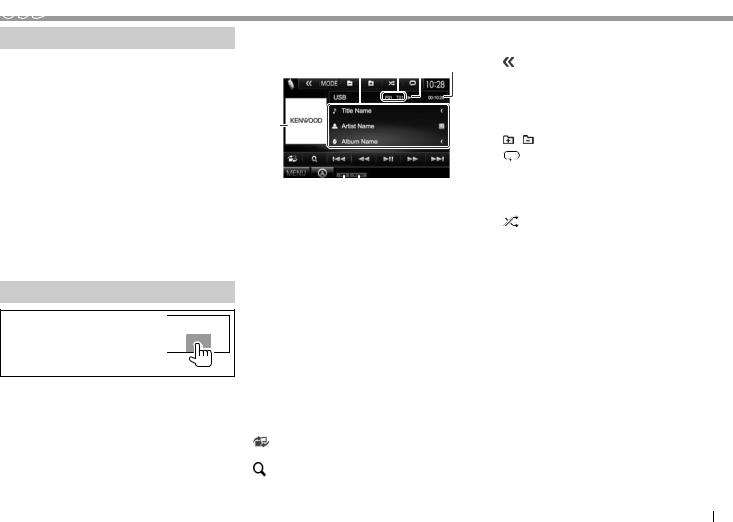
USB
Connecting a USB device
You can connect a USB mass storage class device such as a USB memory, Digital Audio Player etc. to the unit.
•For details about connecting USB devices, see page 56.
•You cannot connect a computer or portable HDD to the USB input terminal.
•For playable file types and notes on using USB devices, see page 61.
When a USB device is connected...
The source changes to “USB” and playback starts.
•All tracks in the USB device will be played repeatedly until you change the source.
To disconnect the USB device safely:
Press [M], then disconnect the USB device after “No Device” appears.
Playback operations
When the operation buttons are not displayed on the screen, touch the area shown on the illustration.
•To change settings for video playback, see page 41.
Indications and buttons on the source control screen
1 2 3 4
56 7
Playback information
1Track/file information (for MP3/WMA/WAV/AAC/ FLAC)
• Pressing [<] scrolls the text if not all of the text
is shown.
2Current playback item information
•MPEG1/MPEG2/H.264/WMV: Folder no., Track no., etc.
•MP3/WMA/WAV/AAC/FLAC: Folder no., Track no., etc.
•JPEG/BMP/PNG: Folder no./File no. 3 Playback status
4 Playing time
5 Jacket picture (Shown while playing if the file has tag data that includes the jacket picture)
6 Playback mode (See the right column.)
7 File type
Operation buttons
[ |
] |
Displays the easy control screen. |
|
|
(Page 8) |
[ |
] |
Displays the list selection screen. |
|
|
(Page 16) |
[S] [T] Selects a track.
[O] [N] |
Reverse/forward search.*1 |
[IW] |
Starts/pauses playback. |
[ ] |
Displays other operation buttons. |
|
• Disabled when there are no other |
|
buttons. |
[MODE] |
Changes the picture display time |
|
|
|
setting on the <USB Mode> screen. |
|
|
(Page 16) |
[ |
] [ ] |
Selects a folder. |
[ |
] |
Selects repeat playback mode.*2 *3 |
|
|
• REP: Repeats the current track/file. |
|
|
• FO-REP: Repeats all tracks/files |
|
|
in the current folder or specified |
|
|
category. |
[ |
] |
Selects random playback mode.*2 *3 |
|
|
• RDM: |
|
|
– When selecting the track/file from |
|
|
the folder, randomly plays all |
|
|
tracks/files of the current folder, |
|
|
then the tracks/files of the next |
|
|
folder. |
|
|
– When selecting the track/file from |
|
|
the category, randomly plays |
|
|
all tracks/files of the specified |
|
|
category. |
[M] |
Disconnects the USB device safely. |
|
[MENU] |
Displays the <TOP MENU> screen. |
|
*1 |
Search speed varies depending on the file type. |
|
*2 |
To cancel random or repeat mode, press the button repeatedly until |
|
*3 |
the indicator disappears. |
|
You cannot activate the repeat mode and the random mode at the |
||
|
same time. |
|
ENGLISH 15
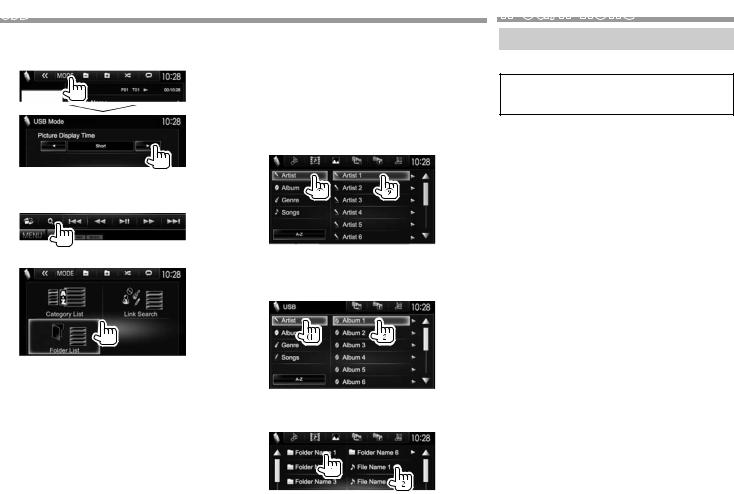
USB
Setting <Picture Display Time>
Set the interval between slides during slide-shows of the picture files.
•On the <Category List>/<Folder List>: You
can switch the file type to list: Press [ ] to list audio files, [
] to list audio files, [
 ] to list video files, or [
] to list video files, or [ ] to list still picture files.
] to list still picture files.
•On the <Category List>/<Link Search>: To list the items in alphabetical order, press [A-Z], then select the first character.
From <Category List>:
Select the category (1), then the item in the selected category (2).
Selecting a track in a list
1
2 Select the list.
3Select the track.
•You can change the page to display more items by pressing [J]/[K].
•Press [ ] to return to the root folder.
] to return to the root folder.
•Press [ ] to return to the upper layer.
] to return to the upper layer.
•Press [ ] to open the folder containing the current track.
] to open the folder containing the current track.
•If you want to play all tracks in the folder, press [I] on the right of the desired folder.
From <Link Search>:
Select the tag type to display the list of contents containing the same tag as the track/file currently played back (1), then the item (2).
From <Folder List>:
Select the folder (1), then the item in the selected folder (2).
iPod/iPhone
Preparation
Connecting iPod/iPhone
•For details about connecting iPod/iPhone, see page 56.
•For playable iPod/iPhone types, see page 62.
Connect your iPod/iPhone according to your purpose or the type of the iPod/iPhone.
Wired connection
•To listen to music:
–For iPod/iPhone except for iPhone 5/iPod touch (5th Generation)/iPod nano (7th Generation), use USB Audio cable for iPod/iPhone— KCA-iP102 (optional accessory)
–For iPhone 5/iPod touch (5th Generation)/ iPod nano (7th Generation), use USB 2.0 cable (accessory of the iPod/iPhone)
•To watch video and listen to music:
–For iPod/iPhone except for iPhone 5/iPod touch (5th Generation)/iPod nano (7th Generation), use USB Audio and Video cable for iPod/ iPhone—KCA-iP202 (optional accessory)
–For iPhone 5/iPod touch (5th Generation)/iPod nano (7th Generation), use the HDMI cable KCA-HD100 (optional accessory) and USB 2.0 cable (accessory of the iPod/iPhone) through Lightning-Digital AV adapter (accessory of the iPod/iPhone)
16

iPod/iPhone
Bluetooth connection
Pair the iPod/iPhone through Bluetooth. (Page 30)
•For iPhone 5/iPod touch (5th Generation)/iPod nano (7th Generation): To watch the video, connect your iPod/iPhone to HDMI/MHL input terminal using KCA-HD100 (optional accessory). (Page56)
•For iPod/iPhone except for iPhone 5/iPod touch (5th Generation)/iPod nano (7th Generation): You cannot watch the video with Bluetooth connection.
Selecting the iPod/iPhone device to play and connection method
When connecting the iPod/iPhone device for first time, the setup screen (for connection, etc.)
appears. Follow the procedure on the setup screen to configure the settings.
1Display the <iPod Settings> screen.
On the <TOP MENU> screen:
•If [Enter] for <iPod Setup> cannot be selected, put the unit in standby. (Page 7)
2
•If you do not need to change the setting, press [OK] to exit from the setup screen.
3Select the connection method (1), then press [Next] (2).
<USB + |
Select this when the iPod/ |
AV-IN> |
iPhone is connected using |
|
KCA-iP202 (optional accessory). |
<USB 1 Wire> Select this when the iPod/ |
|
|
iPhone is connected using |
|
KCA-iP102 or USB 2.0 cable |
|
(accessory of the iPod/iPhone). |
<HDMI + |
Select this when the iPod/ |
Bluetooth> |
iPhone is connected using |
|
HDMI cable KCA-HD100 |
|
(optional accessory) and USB |
|
2.0 cable (accessory of the iPod/ |
|
iPhone) through Lightning- |
|
Digital AV adapter (accessory of |
|
the iPod/iPhone). |
<Bluetooth> |
Select this when the iPod/ |
|
iPhone is connected via |
|
Bluetooth. |
•When selecting <USB + AV-IN> or <USB 1 Wire>, go to step 5.
4When selecting <HDMI + Bluetooth> or
<Bluetooth> as the connection method, the device selection screen appears. Search for the available iPod/iPhone devices (1), then select the target device from the list (2).
•You can change the page to display more items by pressing [J]/[K].
•If the device is already listed, skip the step 1.
•To stop searching, press [Cancel].
5 Confirm the settings.
ENGLISH 17

iPod/iPhone
Selecting preference settings for iPod/ iPhone playback
When the source is “iPod”...
1
2
<Audiobooks> |
Select the speed of audio |
|
books. |
<Wide |
• [ON]: Select this to display |
Screen>* |
the video compatible with |
|
wide-screen display in wide- |
|
screen. |
•[OFF]: Select this to deactivate.
* You cannot change the setting when iPod/iPhone is connected.
Playback operations
When the operation buttons are not displayed on the screen, touch the area shown on the illustration.
•To change settings for video playback, see page 41.
Indications and buttons on the source control screen
1 2 3 4
5
Playback information
1Song/video information
•Pressing [<] scrolls the text if not all of the text is shown.
2 Track no./Total track number
3 Playback status
4 Playing time
5 Artwork (Shown if the song contains artwork)
Operation buttons
[ |
] |
Displays the easy control screen. |
|
|
|
(Page 8) |
|
[ |
] |
Displays the audio/video file list. |
|
|
|
(Page 19) |
|
[S] [T] Selects an audio/video file. |
|||
[O] [N] |
Reverse/forward search. |
||
[IW] |
Starts/pauses playback. |
||
[ |
] |
Displays other operation buttons. |
|
|
|
• Disabled when there are no other |
|
|
|
|
buttons. |
[MODE] |
Changes the settings for iPod/iPhone |
||
|
|
playback on the <iPod Mode> |
|
|
|
screen. (See the far left column.) |
|
[ |
] |
Selects repeat playback mode. |
|
|
|
• |
1: Functions the same as |
|
|
|
“Repeat One.” |
|
|
• |
All: Functions the same as |
|
|
|
“Repeat All.” |
[ |
] |
Selects random playback mode.* |
|
|
|
• |
: Functions the same as “Shuffle |
|
|
• |
Songs.” |
|
|
Album: Functions the same as |
|
|
|
|
“Shuffle Albums.” |
[MENU] |
Displays the <TOP MENU> screen. |
||
*To cancel random mode, press the button repeatedly until the indicator disappears.
18
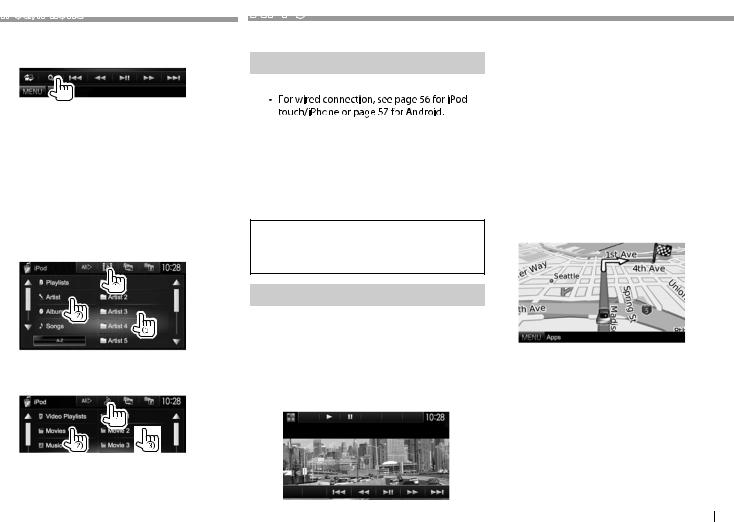
iPod/iPhone
Selecting an audio/video file from the menu
1
2Select the menu ( : audio or
: audio or  : video) (1), a category (2), then a desired item (3).
: video) (1), a category (2), then a desired item (3).
•Select the item in the selected layer until the desired le starts playing.
•You can change the page to display more items by pressing [J]/[K].
•Press[All E] to play all songs/videos.
•Press[ ] to return to the top layer.
] to return to the top layer.
•Press[ ] to return to the upper layer.
] to return to the upper layer.
Audio menu:
• Press[A-Z] to sort the list in alphabetical order.
Video menu:
• Available categories di er depending on the type of your iPod/iPhone.
APPs
You can use an App of the connected iPod touch/ iPhone/Android on this unit.
Preparation
1Connect the iPod touch/iPhone/Android.
–To view the video, connect the device by using KCA-iP202 or KCA-HD100 (optional accessory).
•For Bluetooth connection, see page 32.
2Select the iPod touch/iPhone/Android device to use and connection method on the <APP Setup> screen. (Page 38)
When connecting the device for rst time, the setup screen (for connection, etc.) appears. Follow the procedure on the setup screen to con gure the settings.
Using an App
Playback operations
1Start the App on your iPod touch/iPhone/ Android.
2Select “APPs” 
Operation buttons on the source control screen
[S] [T] Selects an audio/video le.
[O] [N] |
Reverse/forward search. |
[IW] |
Starts/pauses playback. |
[MENU] |
Displays the <TOP MENU> screen. |
For some applications such as navigation applications, the operating buttons and information are not shown. You can perform the operations on the touch panel, such as scrolling the map.
You can also play back the audio/video using iPod/ iPhone instead of the unit.
• When you are using Garmin StreetPilot® Onboard, the screen appears. For Garmin StreetPilot® Onboard for iPhone, visit the Garmin web site: www.garmin.com
Garmin App:
•The current position of your vehicle appears on the map. When the vehicle moves, the map scrolls.
•The screens of the iPhone and unit are not the same.
Switching to the App screen while
listening to another source
Press and hold AV on the monitor panel.
• This operation works only when<AV Key Long Press> is set to [APPs]
ENGLISH 19
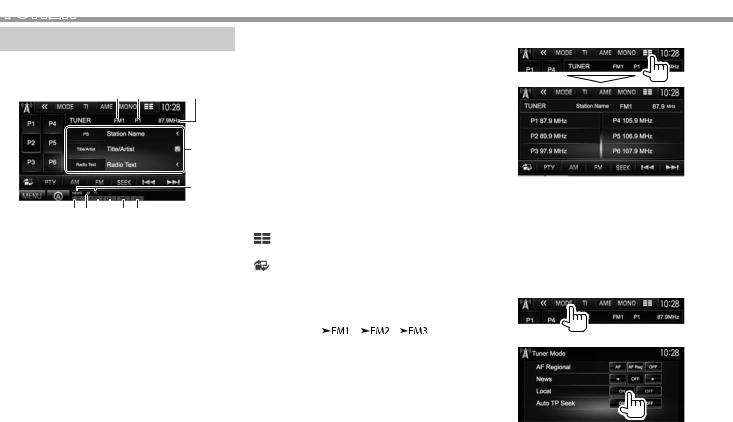
TUNER
Listening to the radio
Indications and buttons on the source control screen
1 |
2 |
3 |
p
q
4 5 6 7 8 9
Tuner reception information
1 Band
2 Preset no.
3 The station frequency currently tuned in
4ST/MONO indicator
• The ST indicator lights up when receiving an
FM stereo broadcast with sufficient signal strength.
5 AF indicator
6 Seek mode
7 LO.S indicator (See the far right column.)
8RDS indicator: Lights up when receiving a Radio Data System station.
9EON indicator: Lights up when a Radio Data System station is sending EON signals.
pText information
•Pressing [<] scrolls the text if not all of the text is shown.
•Pressing [Radio Text] switches the information
between Radio Text, Radio Text Plus, and PTY code.
q Standby reception indicators
Operation buttons
[P1] – [P6] • Selects a stored station. (Press)
• Stores the current station. (Hold)
[MODE] |
Changes the settings for tuner |
|||||||||
|
|
reception on the <Tuner Mode> |
||||||||
|
|
screen. (Pages 20 and 22) |
||||||||
[TI] |
|
Activates/deactivates TI standby |
||||||||
|
|
reception mode. (Page 21) |
||||||||
[AME] |
Presets stations automatically. |
|||||||||
|
|
(Page 21) |
||||||||
[MONO]* |
Activates/deactivates monaural |
|||||||||
|
|
mode for better FM reception. |
||||||||
|
|
(Stereo effect will be lost.) |
||||||||
|
|
• The MONO indicator lights up |
||||||||
|
|
while monaural mode is activated. |
||||||||
[ |
] |
Changes the display information. |
||||||||
(See the right column.) |
||||||||||
|
|
|||||||||
[ |
] |
Displays the easy control screen. |
||||||||
(Page 8) |
||||||||||
|
|
|||||||||
[PTY]* |
Enters PTY search mode. (Page 21) |
|||||||||
[AM] |
Selects the AM band. |
|||||||||
[FM] |
Selects the FM band. |
|||||||||
[SEEK] |
|
|
|
|
|
|
|
|
||
|
|
|
|
|
|
|
||||
Changes the seek mode. |
||||||||||
|
|
• AUTO1: Auto Search |
||||||||
|
|
• AUTO2: Tunes in the stations in |
||||||||
|
|
memory one after another. |
||||||||
|
|
• MANU: Manual Search |
||||||||
[S] [T] Searches for a station.
•The search method differs according to the selected seek mode. (See above.)
[MENU] Displays the <TOP MENU> screen.
* Appears only when FM is selected as the source.
Changing the display information
The preset list and the station name for FM Radio Data System (when PS signal is coming in) are displayed.
•Pressing [ ] again displays the text information for the station currently being received.
] again displays the text information for the station currently being received.
Tuning in FM stations only with strong signals—Local Seek
1
2
[ON] Select this to tune in only to stations with sufficient signal strength. The LO.S indicator lights up.
[OFF] Deactivate the function.
20
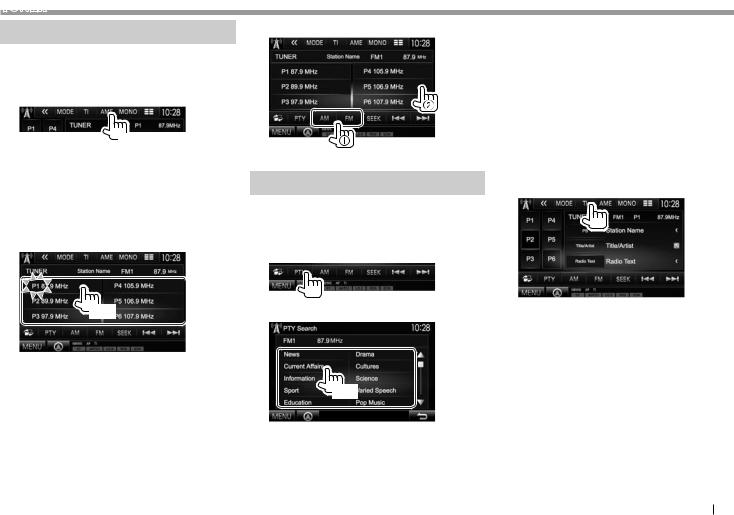
TUNER
Presetting stations
Storing stations in the memory
You can preset 6 stations for each band.
Automaticp resetting—AME(A utoMem ory)
(Hold)
Local stations with the strongest signals are found and stored automatically.
Manualp resetting
1Tune in to a station you want to preset. (Page 20)
2 Select a preset number.
(Hold)
The station selected in step 1 is stored.
Selecting a preset station
FM Radio Data System features
Searching for FM Radio Data System programs—PTY Search
You can search for your favorite programs being broadcast by selecting the PTY code.
1
2 Select a PTY code.
(Hold)
•You can change the page to display more items by pressing [J]/[K].
PTY Search starts.
If there is a station broadcasting a program of the same PTY code as you have selected, that station is tuned in.
•Only English/Spanish/French/German/Dutch/ Portuguese are available for the text language here. If another language has been selected in <Language> (Page 48), the text language
is set to English.
Activating/deactivating TI/News Standby Reception
TI Standby Reception
The unit is in standby to switch to Traffic Information (TI) if available. (The TI indicator lights up in white.)
•If the TI indicator is lit in orange, tune into another station providing Radio Data System signals.
To deactivate TI Standby Reception: Press [TI]. (The TI indicator goes off.)
•The volume adjustment for Traffic Information is automatically memorized. The next time the unit switches to Traffic Information, the volume is set to the previous level.
•For DDX5025DAB: The TI Standby Reception can also be activated or deactivated from “DAB” source control screen. (Page 25)
ENGLISH 21

TUNER
News Standby Reception
1
2
[00min] - Activate News Standby Reception [90min] (the NEWS indicator lights up).
Select the period of time to disable interruption.
[OFF] Deactivate the function.
•The volume adjustment while receiving News is automatically memorized. The next time the unit switches to News, the volume is set to the previous level.
Tracing the same program—Network-
Tracking Reception
When driving in an area where FM reception is not sufficient enough, this unit automatically tunes in to another FM Radio Data System station of the same network, possibly broadcasting the same program with stronger signals.
•When shipped from the factory, Network-Tracking Reception is activated.
To change the Network-Tracking Reception setting
1
2
[AF] Switch to another station. The program may differ from the one currently received (the AF indicator lights up).
[AF Reg] Switch to another station broadcasting the same program (the AF indicator lights up).
[OFF] Deactivate the function.
•The RDS indicator lights up when the
Network-Tracking Reception is activated and an FM Radio Data System station is found.
Automatic TI station seek—Auto TP
Seek
When traffic information station reception is poor, the unit automatically searches for another station that can be received better.
To activate Auto TP Seek
1
2
To deactivate Auto TP Seek: Press [OFF].
22
